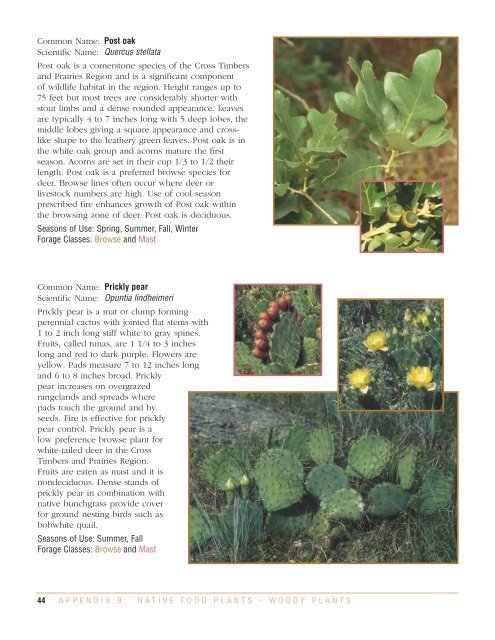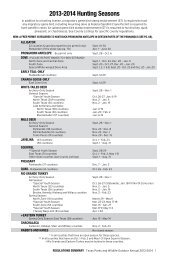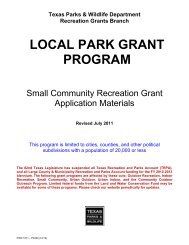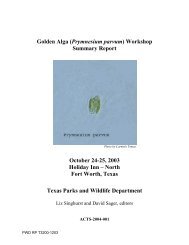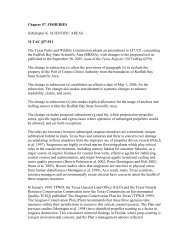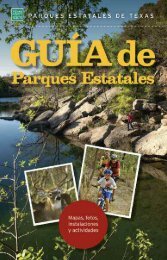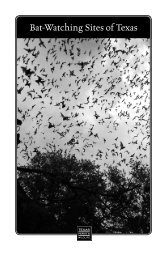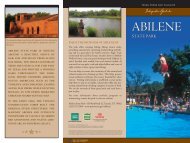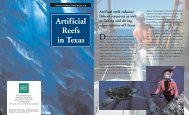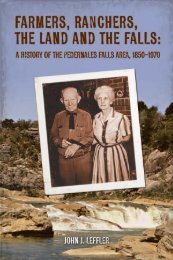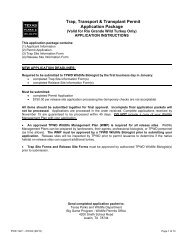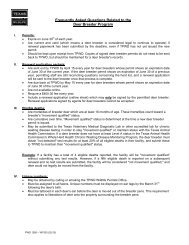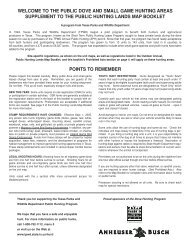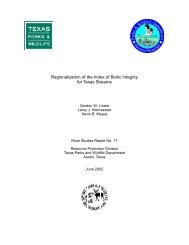White-tailed Deer Food Habits and Preferences in the Cross Timbers
White-tailed Deer Food Habits and Preferences in the Cross Timbers
White-tailed Deer Food Habits and Preferences in the Cross Timbers
Create successful ePaper yourself
Turn your PDF publications into a flip-book with our unique Google optimized e-Paper software.
Common Name: Post oak<br />
Scientific Name: Quercus stellata<br />
Post oak is a cornerstone species of <strong>the</strong> <strong>Cross</strong> <strong>Timbers</strong><br />
<strong>and</strong> Prairies Region <strong>and</strong> is a significant component<br />
of wildlife habitat <strong>in</strong> <strong>the</strong> region. Height ranges up to<br />
75 feet but most trees are considerably shorter with<br />
stout limbs <strong>and</strong> a dense rounded appearance. Leaves<br />
are typically 4 to 7 <strong>in</strong>ches long with 5 deep lobes, <strong>the</strong><br />
middle lobes giv<strong>in</strong>g a square appearance <strong>and</strong> crosslike<br />
shape to <strong>the</strong> lea<strong>the</strong>ry green leaves. Post oak is <strong>in</strong><br />
<strong>the</strong> white oak group <strong>and</strong> acorns mature <strong>the</strong> first<br />
season. Acorns are set <strong>in</strong> <strong>the</strong>ir cup 1/3 to 1/2 <strong>the</strong>ir<br />
length. Post oak is a preferred browse species for<br />
deer. Browse l<strong>in</strong>es often occur where deer or<br />
livestock numbers are high. Use of cool season<br />
prescribed fire enhances growth of Post oak with<strong>in</strong><br />
<strong>the</strong> brows<strong>in</strong>g zone of deer. Post oak is deciduous.<br />
Seasons of Use: Spr<strong>in</strong>g, Summer, Fall, W<strong>in</strong>ter<br />
Forage Classes: Browse <strong>and</strong> Mast<br />
Common Name: Prickly pear<br />
Scientific Name: Opuntia l<strong>in</strong>dheimeri<br />
Prickly pear is a mat or clump form<strong>in</strong>g<br />
perennial cactus with jo<strong>in</strong>ted flat stems with<br />
1 to 2 <strong>in</strong>ch long stiff white to gray sp<strong>in</strong>es.<br />
Fruits, called tunas, are 1 1/4 to 3 <strong>in</strong>ches<br />
long <strong>and</strong> red to dark purple. Flowers are<br />
yellow. Pads measure 7 to 12 <strong>in</strong>ches long<br />
<strong>and</strong> 6 to 8 <strong>in</strong>ches broad. Prickly<br />
pear <strong>in</strong>creases on overgrazed<br />
rangel<strong>and</strong>s <strong>and</strong> spreads where<br />
pads touch <strong>the</strong> ground <strong>and</strong> by<br />
seeds. Fire is effective for prickly<br />
pear control. Prickly pear is a<br />
low preference browse plant for<br />
white-<strong>tailed</strong> deer <strong>in</strong> <strong>the</strong> <strong>Cross</strong><br />
<strong>Timbers</strong> <strong>and</strong> Prairies Region.<br />
Fruits are eaten as mast <strong>and</strong> it is<br />
nondeciduous. Dense st<strong>and</strong>s of<br />
prickly pear <strong>in</strong> comb<strong>in</strong>ation with<br />
native bunchgrass provide cover<br />
for ground nest<strong>in</strong>g birds such as<br />
bobwhite quail.<br />
Seasons of Use: Summer, Fall<br />
Forage Classes: Browse <strong>and</strong> Mast<br />
44 APPENDIX B: NATIVE FOOD PLANTS - WOODY PLANTS


